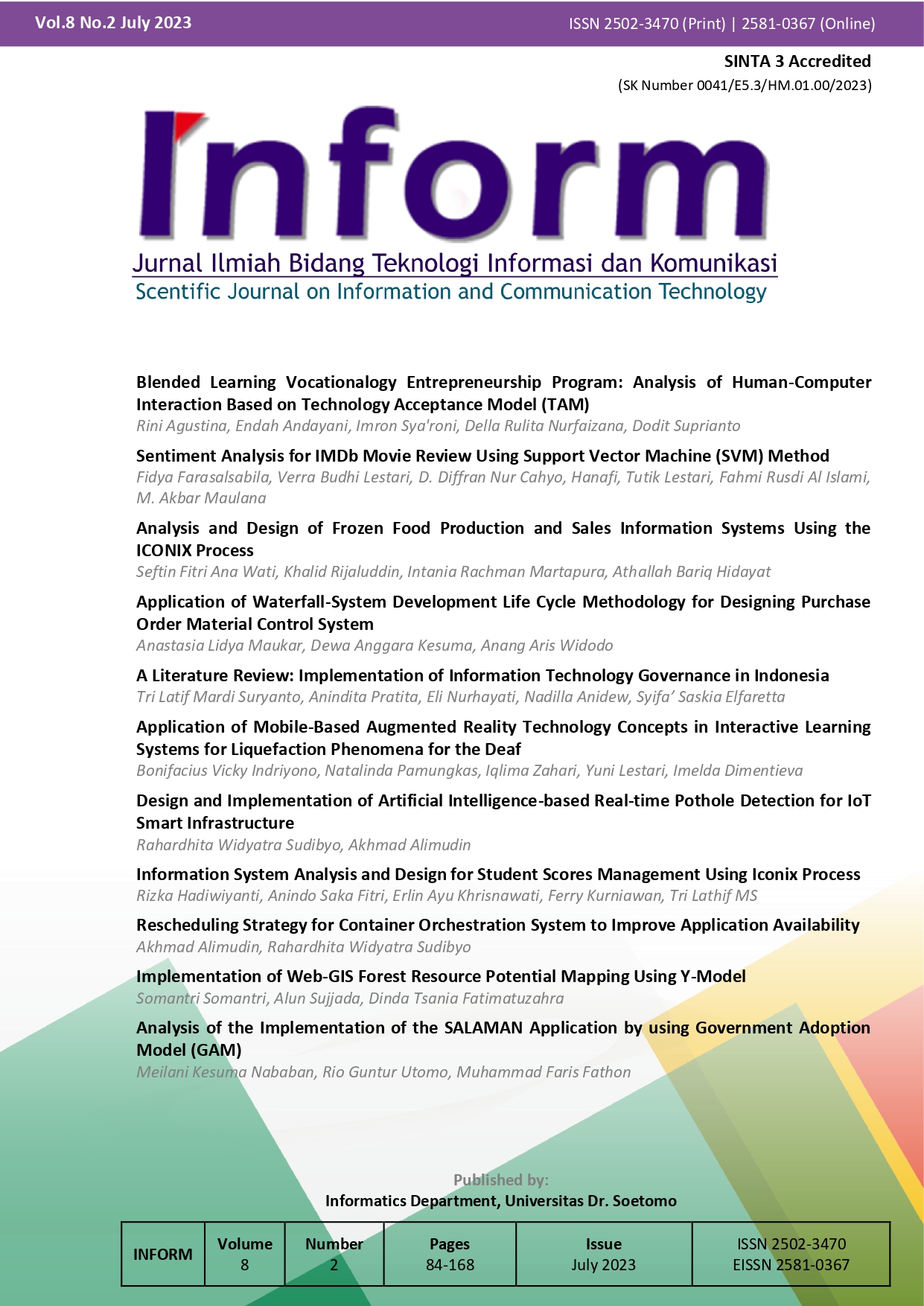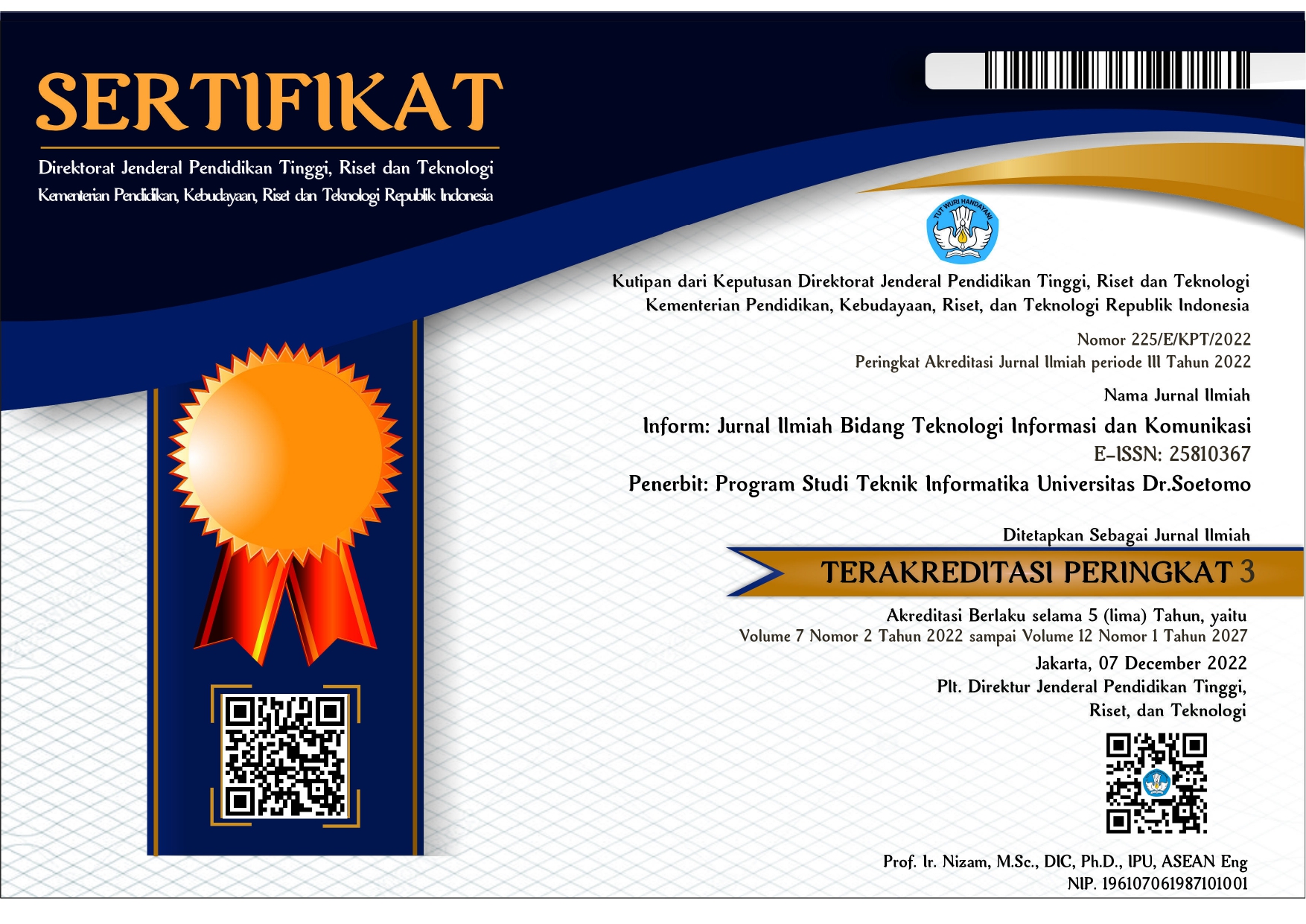Application of Mobile-Based Augmented Reality Technology Concepts in Interactive Learning Systems for Liquefaction Phenomena for the Deaf
 Abstract views: 197
,
Abstract views: 197
,
 PDF downloads: 150
PDF downloads: 150
Abstract
One of the natural disasters currently happening in Indonesia is an earthquake. An earthquake is a condition where the earth shakes due to volcanic activity and collisions due to the movement of the earth's plates. Earthquake activity causes many problems. One of them is liquefaction. Liquefaction is an event that indicates a loss of soil shear strength due to an increase in pore water pressure. This occurs because the earthquake load occurs so quickly and briefly. Liquefaction is an illustration of the effect of an earthquake so that the soil layer loses its strength. The public rarely knows the phenomenon of earthquakes and liquefaction. Not many people know how the process of the movement of the earth is the forerunner of earthquakes, especially people with hearing impairments. They could only feel an earthquake. Therefore, there is a need for education that can be conveyed to the public. Educational techniques in the virtual form will be a special attraction for people, especially people who are deaf or hard of hearing. Augmented Reality (AR) technology is a technology where virtual objects and real objects are combined. The AR is used to create virtual and interactive learning media. This study produced an application as a learning media that utilizes AR technology with the Marker Based Tracking method. The technology was developed using the MDLC (Multimedia Development Life Cycle) method for the learning media to be more interactive. The results of the tests concluded that the application could be used as an interactive learning medium to increase knowledge about earthquakes and the effects of liquefaction on the community.
References
Manoppo.F.J, et al , "Analysis of Liquefaction Potential (Case Study: PLTU Gorontalo Area)", Journal of Civil Statics, Vol.7, No.8, p. 1081-1094, 2013, ISSN : 2337-6732, 2019.
Ihsan, N, et al, “Analysis of Earthquake Fracturing and Aftershocks Using the Omori Method”, Journal of Sciences and Physics Education, Vol. 8, No. 3,pp. 263-268, 2012.
Setyabudi, A.P., “Liquefaction Probability Analysis Using the Liquefaction Severity Index Method for Bantul, Sleman, and Yogyakarta Municipalities”, Final Project, Department of Civil Engineering (Geotechnics) and Environment, Gadjah Mada University, 2013
Iqbal, P., et al., "Quaternary sedimentary facies has the potential for liquefaction in Padang City, West Sumatra Province based on drill core and CPTu data", Journal of Environment and Geological Disasters, Vol. 5 No. 1, pp. 1-18, 2014
Fathani, et al., "Analysis of Potential Liquefaction Levels in the Underpass Area of Yogyakarta International Airportt", Civil Engineering Journal (JRS-Unand), Vol. 16, No.2, pp. 91-104, ISSN : 1858-2133, 2020
Fatirul, et al," Augmented Reality in Science Learning for Elementary School Students", Journal of Educational Technology, Vol. 07, No. 01, pp. 78-90, ISSN: 2338-9184, 2019.
Mustaqim, I, "Utilization of Augmented Reality As Learning Media", Journal of Technology and Vocational Education, Vol.13, No.2, pp. 174-183, ISSN : 0216-3241, 2016
Nazilah, S.; Ramdhan, F.S, "Augmented Reality as a Learning Media for the Introduction of Landmarks of ASEAN Countries Based on Android Using the Marker Based Tracking Method", Journal of IKRA-ITH INFORMATIKA, Vol 5 No. 2, pp. 99-107, 2021
Aprilinda, Y., et al, "Implementation of Augmented Reality for Biology Learning Media in Junior High Schools", EXPLORE Journal of Information Systems and Telematics, Vol. 11, No. 2, pp. 124-133, ISSN : 2087-2062, 2020.
Haryani, P., "Augmented Reality (AR) As Interactive Technology In Introducing Cultural Heritage Objects To The Community", SIMETRIS Journal, Vol 8, No 2, pp. 807-812, ISSN : 2252-4983, 2017.
Mustaqim, I.; Kurniawan, N., "Development of Augmented Reality Based Learning Media", Electrical Education Journal, Vol. 1, No. 1, pp. 36-48, ISSN : 2548-8260, 2017
Mahendra, I.B.M., "Implementation of Augmented Reality (AR) Using Unity 3d and Vuporia SDK", COMPUTER SCIENCES Scientific Journal, Vol. 9, No. 1, pp. 1-5, ISSN : 1979 – 5661, 2016.
Anshori, Y.; Joefrie, Y.Y., "Augmented Reality Technology", MEKTEK Scientific Magazine, Year XIII, No. 3, 2011.
Sugiyono, Quantitative Research Methods, Qualitative, and R&D.Bandung : Alfabeta. 2017.
Arikunto, S. Research procedure. Jakarta: Rineka cipta.
Ramansyah, W., "Development of Interactive Learning Multimedia with the Theme of Recognizing Hijaiyah Letters for Elementary School Students", Edutic Scientific Journal, Vol.3, No.1, pp. 28-37, ISSN : 2407-4489, 2016.
Armansyah, F. Et al, "Interactive Multimedia as a Media Visualization of the Basics of Animation", JKTP Journal of Educational Technology Studies, Vol 2 No. 3, pp. 224-229, ISSN : 2615-8787, 2019.
Munir, R., "Multimedia Concepts And Applications In Education", Bandung : Alfabeta, 2015
Saprudin, S., et al, "Multimedia Learning (Case Study: Global Indonesian Vocational School)", Jamaica: Community Service Journal, Vol. 1, No. 1, pp. 63–70, 2020.
Atmawarni,, U.M.A., "Use of Interactive Multimedia to Create Innovative Learning in Schools.", Journal of Social Sciences, Vol. 4, No.1, pp. 20-27, ISSN : 2085 – 0328, 2011.
Aryaningrum, K, "Use of Interactive Multimedia Internet to Improve Student Learning Outcomes in Social Studies Learning", Harmony, Vol. 2, No.2, pp. 119-129, 2017.
Setyawan, et al., "Augmented Reality in Science Learning for Elementary School Students", Journal of Educational Technology, Vol. 7, No. 1, pp. 778-90, ISSN : 2338-9184, 2019.
Mustaim, I, "Utilization of Augmented Reality As Learning Media", Journal of Technology and Vocational Education, Vol.13, No.2, pp. 174-183, 2016.
Fernando, M., "Creating Augmented Reality Applications Using Vuforia SDK and Unity", Thesis, Informatics Engineering Study Program: Universitas Klabat Manado, 2013.
Rompas, M., et al "Design of the Unsrat Faculty of Engineering Building with a 3D Perspective". Unsrat Informatics Engineering Journal, Vol. 2 No. 2. ISSN: 2301-8364, 2013.
Waeo, V, et al, "Implementation of Human Movement in 3D Animation Using the Pose to Pose Method", Informatics Engineering E-journal, Volume 9, No 1, pp. 1-8, ISSN : 2301-8364, 2016
Wati, T.L; Novita, D., "Image Analysis of Deaf Students in View of the Meaning of Visual Language (Shape and Color) at SLB Dewi Sartika Geluran Sidoarjo", Proceedings of The ICECRS National Seminar FKIP UMSIDA, Vol. 1 No 3 ,pp. 1-12 ISSN. 2548-6160, 2018.
Pujiastuti, A.U., et al, "Analysis Writing Skills Of Students With Hearing Disabilities At Inclusive Elementary School", Jurnal Pendidikan Dasar Nusantara, Vol. 4, No. 1, pp.1-11 ,ISSN 2460-6324.2018.
Nofiaturrahmah,F., "Problems of Deaf Children and How to Overcome Them", QUALITY, Vol. 6, No. 1, pp. 1-15,2018.
Pradipta, R.F; Lesmana, L. "Analysis of the Causes of Deaf Children's Difficulties in Compiling Simple Sentences", Orthopedagogic Journal, Vol. 1 No. 2, pp. 36-44. 2020.
Nugraheni,A.S., et al. “Optimizing the Use of Sign Language with Sibi and Bisindo for Deaf Disabled Students in the Pgmi Study Program, Uin Sunan Kalijaga”, HOLISTIK Scientific Journal of PGSD, Vol. V No. 1 Mei, pp. 28-33, ISSN. 2579 - 6151, 2021.
Handayani, M.A, “Communication of Deaf Children with Sign Language at SLB B Yakut Purwokerto”, INJECT (Interdisciplinary Journal of Communication), Vol. 3, No. 2, pp.213-230 , ISSN. 2548-5857,2018.
Annisa,A., et al, "Designing Sign Language Conversion Applications to Alphabets and Numbers Based on Augmented Reality Using 3D Object Tracking Techniques", JOIN, Vol. 2, No. 1, pp. 25-29, ISSN. 2527-9165, 2017..
Lonteng, C.V.D., "Liquidation Potential Analysis at PT. PLN (Persero) UIP KIT SULMAPA PLTU 2 North Sulawesi 2 x 25 Mw Power Plan", Journal of Civil Statics, Vol.1 No.11, pp. 705-717, ISSN : 2337-6732, 2013.
Huagalung, M.; Tarigan, S.D., “Analysis of Potential Liquefaction Due to the Earthquake (Case Study: Reclamation of Belawan Container Port Phase-2)”, Journal of Civil Mechanics Construction Engineering, Vol. 2 No.1, pp. 15-23, ISSN : 2614-5707, 2019.
Copyright (c) 2023 Bonifacius Indriyono, Natalinda Pamungkas, Iqlima Zahari, Yuni Lestari, Imelda Dimentieva

This work is licensed under a Creative Commons Attribution-ShareAlike 4.0 International License.
Authors who publish with Inform: Jurnal Ilmiah Bidang Teknologi Informasi dan Komunikasi agree to the following terms:
-
Authors retain copyright and grant the journal right of first publication with the work simultaneously licensed under a Creative Commons Attribution License (CC BY-SA 4.0) that allows others to share the work with an acknowledgment of the work's authorship and initial publication in this journal.
-
Authors are able to enter into separate, additional contractual arrangements for the non-exclusive distribution of the journal's published version of the work (e.g., post it to an institutional repository or publish it in a book), with an acknowledgment of its initial publication in this journal.
-
Authors are permitted and encouraged to post their work online (e.g., in institutional repositories or on their website) prior to and during the submission process, as it can lead to productive exchanges, as well as earlier and greater citation of published work.











